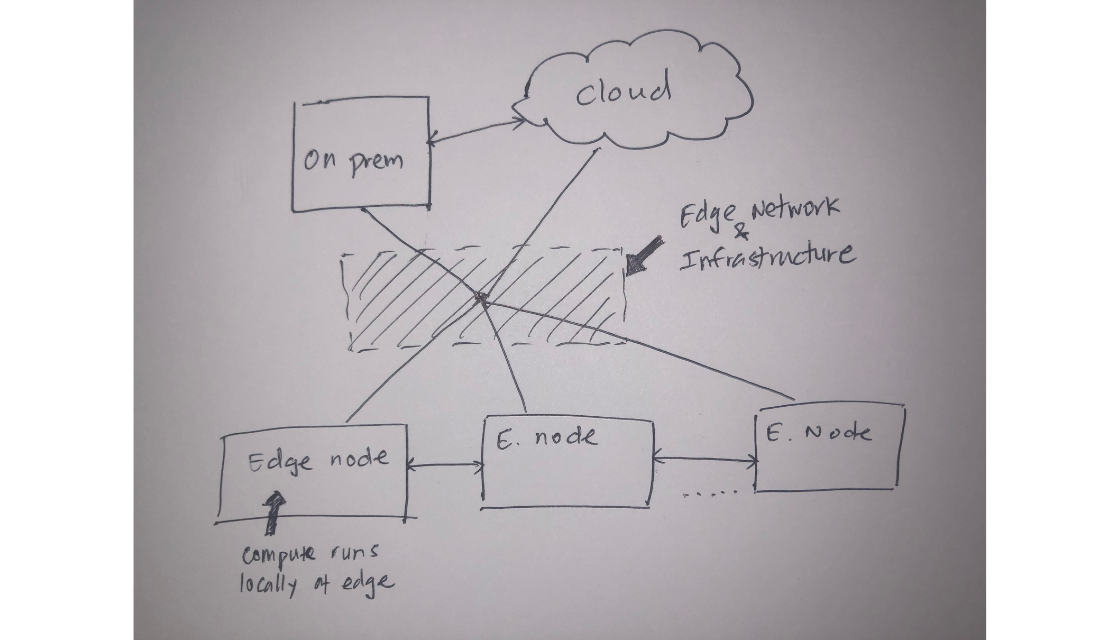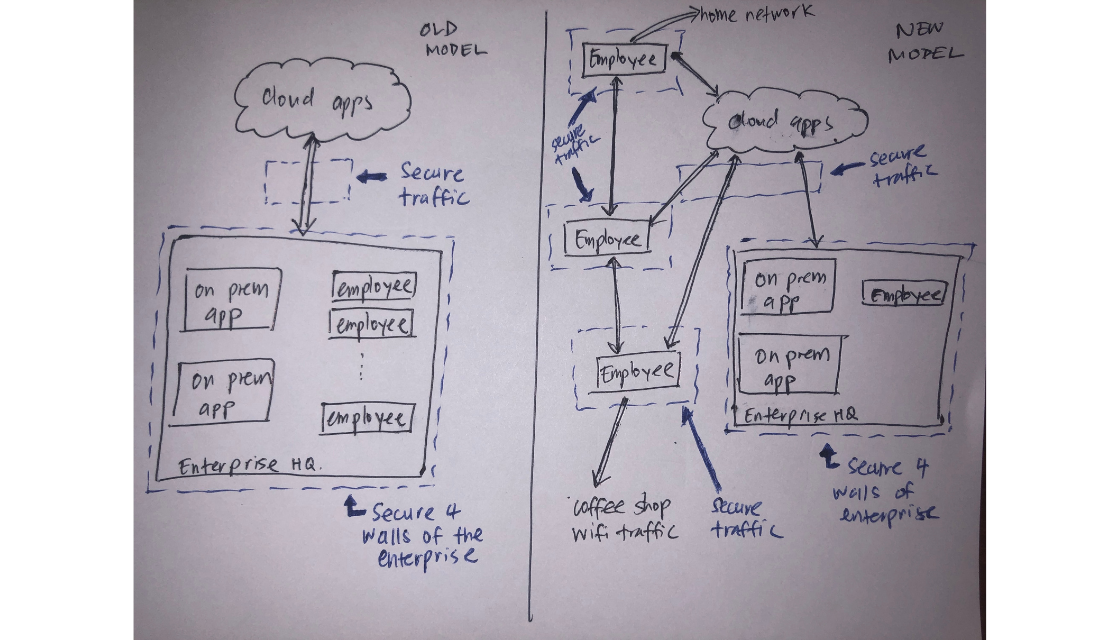Not long ago (though it may feel like it given the times), edge computing was the talk of the enterprise. Now, as this year’s experiment with working remotely turns into something more permanent for many, that radical shift is the headline everyone is writing about.
Well, if you think about it, they’re actually not that different.
What I mean is: The mass migration we’re seeing with enterprises moving to distributed models actually parallels the shift we’ve seen many of those same companies make to edge computing. It may sound like a cheap framework, but if you dig in, I believe it actually holds true. It’s clear the next big challenge (and opportunity) will be in building tools and systems that support these new structures.
Let me explain...
Edge computing is the concept of using smarter devices, infrastructure, and algorithms to improve performance of an overall system. There’s still a centralized backend, but more of the data processing happens at or near the endpoint to encourage localized actions and real-time insights. It takes many forms from improving existing applications (hello, better responsiveness on mobile devices), to opening up entirely new verticals, (hello to the autonomous vehicle industry which runs almost entirely on edge computing). The benefits of edge are clear: better resiliency, efficiency and overall system performance.
Before this year, enterprises actually operated a lot like the current cloud model – humans (devices) came together in HQ (cloud) and performed work (algorithms and compute) together. In many ways, COVID has forced companies to evolve from a centralized cloud computing architecture to a more distributed, edge model. We are no longer together in a single office, and with that, are forced to find ways to be productive, communicate seamlessly with others, and make decisions, all while still maintaining a cohesive, working system.
See my perfectly diagrammed sketch below:
The question I’ve been asking myself and others is:
As companies go remote and rely on individuals to do work outside of traditional HQ, does this “enterprise edge” model (or just “edge” as I’ve been calling it) hold up as you take it further – and if it does, is there anything we can learn?
The more time I’ve spent, the more I believe that the future of enterprises is at the “edge” and where new opportunities will pop up. But just as the move from cloud to edge computing requires a big change in devices, data, and software to maximize performance, so does the transition to the “edge” and the systems supporting talent, infrastructure and productivity.
That’s what I attempt to explain below.
I also went a little further and built out this matrix noting the new solutions I expect to see within talent, infrastructure and productivity, as well as key questions that need to be addressed. (H/T to Eniac VC for the inspiration.)
But first, a few thoughts on talent, infrastructure and productivity.
Employee location is mostly irrelevant
The performance of a cloud compute system is determined by the time spent using the centralized cloud resources, while edge compute is judged by the work done on the edge device. It’s a slight reframing of incentives, but results in a more resilient and faster system. In a similar framing, while time at the office does correlate to employee contribution, the true measure of productivity should be output regardless of much time spent or effort perceived – and that’s what an edge model values.
In this model, location is irrelevant and companies can optimize their team, not for the best talent in a particular region, but the best talent in any region. So what happens? The available talent for a position suddenly increases by orders of magnitude. When we think about a startup’s edge and defensibility, that’s a massive competitive advantage for any business. It’s exactly why big companies like Facebook, Twitter, Shopify and Atlassian, but also growth companies like UpWork, Coinbase and Lambda School have already realized the benefits of a distributed talent pool and are permitting employees to work remotely on a permanent basis. It’s also why Glassdoor is reporting remote job openings are up 28.3% from a year ago.
The way that companies hire, train, and evaluate talent will completely change and a wave of new startups (offering both products and services) will be developed to meet these new demands. In particular, I’m excited about companies thinking about more systematic ways to leverage the talent arbitrage the “edge” creates. If a company eliminates the arbitrary “location” filter and optimizes around targeted skill sets required for the actual role, it will result in a higher quality team. All companies will still search for the best talent, but because location is now irrelevant, the traditional referral pipeline will change, too and I believe an entirely new ecosystem will need to be built to service this need.
More on the solutions I expect to be built in talent and key questions companies need to answer here.
New entrants shaking up once sleeply infrastructure sectors
Devices with better compute are just one aspect of building for the “edge.” There are also the aspects of infrastructure and software that power the system. At the “edge,” the infrastructure required looks very different than the cloud model, and with that comes opportunity.
The short version is that traditional IT doesn’t work when employees go remote. IT was built for a centralized and hierarchical topology of traditional enterprise and to support workforces within a traditional enterprise campus accessing applications through a defined set of rules and networks. It wasn’t built for a distributed enterprise where employees use different computers and devices, with some signing in from a corporate network, while others from their apartment, local coffee shops or Airbnb.
Again, see my perfectly diagrammed sketches comparing the old model to the new:
Some of the biggest (and sleepiest) infrastructure sectors will undergo a massive transformation. The derivative efforts of this are vast, but I’m most interested to see what happens in the areas of access, resiliency, and provisioning.
VPNs are already seeing some of this. I would guess nearly every enterprise has a traditional VPN for remote access of data and applications. The experience is slow and clunky under normal circumstances, but also effective when employees need to use a device off traditional networks. It’s a fairly stable $20+ billion market dominated by incumbents like Cisco and F5. In March 2020 (when COVID forced nearly every company to become an “edge company” if you will), VPN usage spiked 40%+, rapidly expanding an already large market, but also revealing its brittle nature. Companies like Axis Security have started to penetrate the market with a modern solution for today’s enterprise, but we’re very much still in the early days. As the “edge” model gets adopted widely, I also expect we’ll see the emergence of a mesh network with IT as it’s now charged with monitoring and protecting a very, very different enterprise.
More on the solutions I expect to be built in infrastructure and key questions companies need to answer here.
Collaboration is very different when distributed teams are the rule vs. the exception
Gaining access to top talent is an obvious advantage for any company. Building the infrastructure required to support those individuals is the next step. The final piece is how companies enable those people and teams to actually communicate and collaborate to perform work, both synchronously and asynchronously.
Those concepts aren’t new, but the frequency at the “edge” is. The “edge” lends itself to asynchronous work because each employee is their own node empowered to work at their optimal time and pace. In that system, asynchronous becomes equally (if not more) important, meaning companies must put an even bigger emphasis on making those communications clear and effective, as well as keeping synchronous communication as focused as possible. This opens up an opportunity for new tools that allow information to flow between teammates, as well as decisions to be made without the traditional concept of meetings. I firmly believe that products like Notion and Roam (both better documentation) and Threads (asynchronous decision-making) will be staples in any “edge” company.
On the synchronous side, the best companies are using Zoom, Google Meet, and Teams not as a temporary replacement for in-person meetings, but rather as the on-ramp to more efficient ways to leverage voice and video data in the enterprise. I believe the next generation of synchronous solutions will take the digital data from video-voice meetings, and build automated workflows to make meetings more actionable and productive. Automating voice and video capture is going to be a staple, with companies like Fireflies.ai (disclaimer: I’m an investor) already starting by intelligently routing information from a meeting through a user’s workflow (whether that be sales data into a CRM, documentation data into Notion, etc.)
Of course, you can’t have a conversation about collaboration and COVID without also giving a H/T to those companies above for providing the foundational infrastructure to enable companies to quickly adjust to a distributed enterprise environment. The thing is though is that these tools were optimized for a world where distributed teams were the exception vs. the rule. The next wave will not only work in a distributed enterprise, but will be purpose built for it and emphasize different aspects of work. I expect they’ll leverage the infrastructure and reach of those existing platforms to build applications on top that will allow “edge companies” to not only maintain, but excel.
Lastly, what’s exciting about the evolution of synchronous and asynchronous tools at the “edge” is that the dominant GTM model will be product-led, through primarily bottoms-up adoption. Because each employee is their own node, they’ll be more empowered to choose the tools that boost their output, which will lead to this next wave to be product-led and grow virally. The “consumerization of the enterprise” concept is well-documented by investors such as Nikhil Basu Trivedi and will only be reinforced by the next generation.
More on the solutions I expect to be built in collaboration and key questions companies need to answer here.
So now what?
Whether they like it or not, COVID has forced every company to preview the “edge.” Barriers to building these kinds of systems – whether lack of technology, social stigma, or some combination of the two – have always existed, but this pandemic has changed things.
We’ll see if companies stay this way, move back to a more centralized structure, or a hybrid of the two, but it’s clear that new opportunities in talent, infrastructure and collaboration have been revealed and are too big to ignore. Just like edge computing architectures have enabled advances to existing applications, as well as new verticals, I believe companies that are first to build for the “edge” will be the leaders in a new game, where they will get to set the rules and reap early rewards.
I’d love your thoughts on this framework, as well as feedback and additions on the many sub-categories of talent, infrastructure and collaboration I’ve added here. It’s a living document that I hope to add to and update as we all adjust to the new (and old) ways of work.
.jpg)

